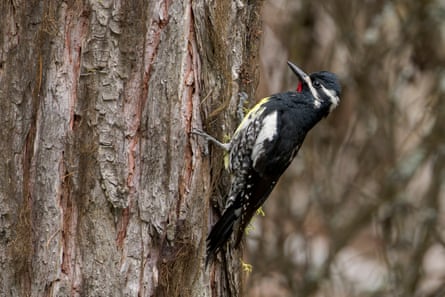Bird populations across North America are falling most quickly in areas where they are most abundant, according to new research, prompting fears of ecological collapse in previously protected areas.
Analysis of nearly 500 bird species across North America has found that three-quarters are declining across their ranges, with two-thirds of the total shrinking significantly.
The study, published in the journal Science, indicates that former strongholds for bird species are no longer safe, particularly in grasslands, drylands and the Arctic.
In one of the most ambitious uses of citizen science data so far, scientists at Princeton University used observations from eBird, a popular application used by birdwatchers to record sightings, to model changes between 2007 and 2021. The granularity of the data allowed researchers to track the rate of change in 27 sq km (10 sq miles) segments across North America, showing dramatic declines in areas where less than two decades ago bird species had thrived.

“We’ve known for several years that a lot of bird species in North America have been declining. With this study, we were aiming to understand in much finer spatial resolution where birds were declining and where they might be increasing. Rather than having a range-wide trend to see if a species is going up or down, we want to know where it is going up and down,” said Alison Johnston, director of the Centre for Research into Ecological and Environmental Modelling, who led the study.
“The main ecological finding is that the locations where these species were thriving in the past, where the environments were really well suited to birds, are now the places where they are suffering the most,” she said.
The researchers said further studies were needed to explain the reasons behind the changes, many of which were dramatic, with populations falling by more than 10% a year in some areas. Global heating and habitat change were put forward as the main theories behind the shifts, but Johnston said they ultimately did not know.
“The way I interpret this result is that it’s indicative of major changes in our world,” she said. “The fact that where birds used to have strongholds, where there used to be a lot of resources, where the environments were really suitable, are now the places where they are declining most, that suggests to me that we are just seeing fundamental changes to the environments around us. The birds are like the canary in the coalmine,” she said.
The research adds to a recent series of studies that have documented severe declines of birds in nature reserves and protected areas.
Despite the worrying overall picture, the researchers found pockets of stability in bird populations in their analysis, such as the Appalachians and western mountains. In addition, 97% of all bird species had some pockets where their populations were increasing.
The team at Princeton University has previously developed methods for reliably converting citizen science observations in apps such as eBird into data that can be used to monitor population changes in a single species. The study authors only included results that had passed strict reliability checks.
Prof Amanda Rodewald from the Cornell Lab of Ornithology, a co-author on the study, said the methods would allow conservationists to target their efforts.
“It is this kind of small-scale information across broad geographies that has been lacking and it’s exactly what we need to make smart conservation decisions,” she said. “These data products give us a new lens to detect and diagnose population declines and to respond to them in a way that’s strategic, precise and flexible. That’s a gamechanger for conservation.”
Ian Burfield, a global science coordinator with BirdLife, who was not involved in the study, welcomed the research and said it highlighted areas for further investigation.
“North American birds are one of very few taxonomic groups and regions where such data exist to facilitate this approach. This emphasises the vital need for more field data collection, both through formal monitoring schemes and citizen science efforts, in many other parts of the world, especially in the biodiversity-rich tropics,” he said.
Find more age of extinction coverage here, and follow the biodiversity reporters Phoebe Weston and Patrick Greenfield in the Guardian app for more nature coverage

 5 hours ago
7
5 hours ago
7













































